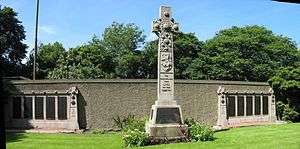Rosebank Cemetery
|
Memorial to soldiers killed in the Gretna rail disaster of 1915. | |
| Details | |
|---|---|
| Established | 1846 |
| Location | Pilrig, Edinburgh |
| Country | Scotland, UK |
| Type | Public |
| Size | 4.37 hectares (10.8 acres) |
Rosebank Cemetery is a 19th-century burial ground in Edinburgh, Scotland. It is located at the junction of Pilrig Street and Broughton Road in the Pilrig area, close to the historical boundary of Leith. The cemetery is protected as a Category C(s) listed building.[1]
History
The cemetery was developed by the Edinburgh and Leith Cemetery Company,[2] with David Cousin as architect, and opened on 20 September 1846.[1] It covers an area of 4.37 hectares (10.8 acres). Originally known as the Edinburgh and Leith Cemetery,[3] the cemetery proved popular and was extended eastwards around 1880.
The main entrance was originally from the north-west (Broughton Road) but this has been sealed. The sole entrance is now from the north-east (Pilrig Street). The latter originally had an entrance lodge above the gate, but this was demolished around 1975.
The cemetery was in independent private ownership until around 1980 when the City of Edinburgh Council then took over the grounds.
Memorials
A large memorial at the furthest point lying against the Bonnington Road boundary marks a mass grave and commemorates the Gretna rail disaster of 22 May 1915, in which 215 soldiers of the 1st/7th Battalion The Royal Scots were killed.[2] The men, mostly from Leith, were on their way to board ship at Liverpool in order to travel to the battlefront at Gallipoli. The handful of survivors were sent onwards the following day. The bodies of those killed in the railway disaster were returned to Leith and buried with great aplomb on 24 May with the 15th and 16th battalions Royal Scots serving as guard of honour. These are among 270 First World War casualties and 36 Second World War casualties interred at Rosebank.[4]
A number of 19th-century merchants and ship owners from Leith are buried at Rosebank. There are also several 20th-century Sikh and Islamic burials.
Those who are homeless and die on the street along with several stillborn children (Scots law requires burial not cremation) are buried at the cemetery. The latter are marked by a modern monument giving a place to remember them, in interlocking granite pieces representing mother and child. The inscription reads "to all those children never known but always loved".
An abnormally high number of stones are noted as "drowned" or "lost at sea" (see Notable Interments). Other strong maritime links are evidenced in the high number of Shipmasters, Shipowners, Shipchandlers etc.
Notable interments

- Thomas Aitken (1833-1912), Provost of Leith from 1887-1893
- James Bertram (1816-1861), engineer
- Rev William Garden Blaikie, (1820-1899)
- Alan Brebner (d. 1890), civil engineer and an associate of lighthouse designers David and Thomas Stevenson.
- A rare female war grave from World War I to E.G.Elder of the Women's Royal Naval Service d.7.7.1918, plus a female war grave from World War II to E.W.L.Fruish, also Women's Royal Navy Service
- M.P. Galloway (1843-1919), shipbuilder
- Andrew Leslie (1818-1894), shipbuilder
- Robert Lindsay, pharmacist, co-founder of Lindsay & Gilmour
- Sydney Mitchell (1856–1930), architect and his father Sir Arthur Mitchell (1826-1909)
- James Campbell Noble RSA (1846-1913), artist
- Thomas Peddie (1844-1911), railway and civil engineer
- George Ogilvy Reid (1851-1928), artist
- Ornate monument to Thomas Reid, nurseryman (1805-1848) by Hector Heatly Orrock (1831-1862)
- Christian Salvesen (1827–1911), Norwegian merchant who settled at Leith and founded the company which now bears his name
- James Slight (1785-1854), assistant engineer to Robert Stevenson in the building of the Bell Rock Lighthouse[5] and other lighthouse projects[6] and his brother, Alexander Slight (1818-1885) also an engineer
- Henry Stephens (1794-1874), author of The Book of the Farm
- A pair of stones towards the southeast memorialise several members of the Stevenson family drowned in the Eyemouth disaster of 14 October 1881. One is noted as having been "interred 3 March 1882", his body having been washed ashore and identified five months later.
- Andrew Young (1807-1889), author of the hymn There Is a Happy Land
References
- 1 2 "Rosebank Cemetery:Listed Building Report". Historic Scotland.
- 1 2 "Rosebank Cemetery (Edinburgh and Leith Cemetery)". Gazetteer for Scotland.
- ↑ http://maps.nls.uk/view/102190564
- ↑ "Rosebank Cemetery". Commonwealth War Graves Commission.
- ↑ http://200.bellrock.org.uk/biographies.htm
- ↑ http://www.engineering-timelines.com/scripts/engineeringItem.asp?id=182
External links
- Rosebank Cemetery, Royal Commission on the Ancient and Historical Monuments of Scotland
- Inscriptions of Tombstones in Rosebank Cemetery
Coordinates: 55°58′04″N 3°11′06″W / 55.9677°N 3.1850°W
